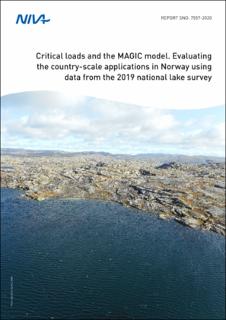Critical loads and the MAGIC model. Evaluating the country-scale applications in Norway using data from the 2019 national lake survey
Research report
Published version
Permanent lenke
https://hdl.handle.net/11250/2725461Utgivelsesdato
2020Metadata
Vis full innførselSamlinger
- NIVA-rapporter [6992]
- Publikasjoner fra Cristin - NIVA [2149]
Sammendrag
The critical loads methodology used at the national scale in Norway and the MAGIC model as applied to the lakes in the national 1000-lake survey have been evaluated, making use of the data from the 2019 national lake survey. For the acid-sensitive lakes in southern/middle Norway the MAGIC simulations based on data from the 1995 survey gave an acceptable prognosis for the lakewater chemistry measured in the 2019 resurvey. Several potential improvements are suggested for a re-calibration of MAGIC using the 2019 data, including two-point calibration. This can be used to evaluate scenarios of changed acid deposition in concert with other environmental drivers, such as climate change and altered forestry practices. The future role of N deposition is of special interest. Most lakes in the areas with critical load exceedance were not acidified. Several possible explanations for this are given. Testing various alternative values for inputs and parameters in the critical loads and exceedance calculations showed that certain combinations of changes could have marked effects on the critical load exceedance. Two approaches to updating the critical loads are suggested: 1) Calculate critical loads for the 1000 lakes and transfer the results to the national grid. 2) Keep the current setup but updating some of the inputs. Independent of choosing 1) or 2), the FAB model parameters should be re-visited.
Beskrivelse
Project Manager Kari Austnes
Utgiver
Norsk institutt for vannforskningSerie
NIVA-rapport;7557Miljødirektoratet-rapport;M-1874
